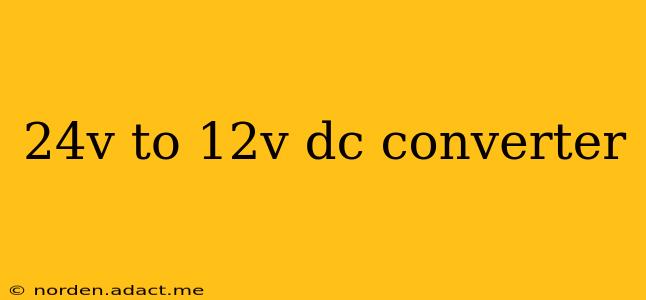Converting 24V DC to 12V DC is a common requirement in various applications, from automotive systems and industrial equipment to powering smaller devices from higher-voltage sources. Understanding the different types of converters available, their specifications, and choosing the right one for your needs is crucial. This guide provides a comprehensive overview, answering common questions and offering valuable insights.
What is a 24V to 12V DC Converter?
A 24V to 12V DC converter is a device that steps down a 24-volt DC power source to a 12-volt DC output. This is achieved using various electronic circuits, most commonly employing switching regulators for high efficiency. These converters are essential when you have a 24V power supply but need to power devices that operate on 12V. Think of them as voltage transformers, but specifically designed for direct current.
How Does a 24V to 12V DC Converter Work?
The most common type of 24V to 12V DC converter uses a switching regulator. This involves rapidly switching a transistor on and off at a high frequency. This creates a pulsed DC signal, which is then smoothed out using a filter to produce a clean 12V DC output. The switching frequency allows for smaller and more efficient components compared to linear regulators. The efficiency of a switching regulator is typically much higher than a linear regulator, meaning less energy is lost as heat.
What are the Different Types of 24V to 12V DC Converters?
Several types of converters exist, each with its advantages and disadvantages:
- Buck Converters: These are the most common type used for stepping down voltage. They are highly efficient and widely available.
- Linear Regulators: While simpler, they are less efficient than buck converters, especially at higher current loads, dissipating excess voltage as heat. They are rarely used for high-power applications.
- Isolated Converters: These provide galvanic isolation between the input and output, improving safety and preventing ground loops. They are essential in applications where electrical isolation is crucial.
What are the Key Specifications to Consider When Choosing a 24V to 12V DC Converter?
Choosing the right converter involves carefully considering several key specifications:
- Input Voltage Range: The range of 24V input voltages the converter can handle.
- Output Voltage: The regulated 12V DC output.
- Output Current: The maximum current the converter can supply. This is crucial to ensure it can power your devices.
- Efficiency: Expressed as a percentage, indicating how much of the input power is converted to useful output power. Higher efficiency means less wasted energy and heat.
- Size and Mounting: Physical dimensions and mounting options (e.g., through-hole, surface mount).
- Protection Features: Features such as short-circuit protection, over-voltage protection, and over-temperature protection are crucial for safety and reliability.
What are Some Common Applications for 24V to 12V DC Converters?
24V to 12V DC converters find applications in a wide range of scenarios:
- Automotive: Powering 12V accessories in vehicles with a 24V electrical system (common in trucks and buses).
- Industrial Control Systems: Supplying power to 12V sensors, actuators, and controllers within a 24V system.
- Telecommunications: Providing power to 12V equipment in a 24V infrastructure.
- Power Supplies: Stepping down a 24V power supply for use with 12V devices.
How Much Current Can a 24V to 12V DC Converter Handle?
The current handling capability of a 24V to 12V DC converter varies widely depending on the model and its design. You must always check the output current rating specified by the manufacturer. Using a converter with insufficient current capacity will result in overheating and potential damage.
How Efficient are 24V to 12V DC Converters?
Modern switching converters boast high efficiency, typically ranging from 80% to 95%. Linear regulators, however, are significantly less efficient, often in the range of 50% to 70%. Efficiency is directly related to heat generation – higher efficiency means less wasted energy as heat.
What are the Safety Precautions When Using a 24V to 12V DC Converter?
Always follow these safety precautions:
- Check the specifications: Ensure the converter is rated for the required voltage and current.
- Proper wiring: Use appropriately sized wires and connectors to avoid overheating and short circuits.
- Heat dissipation: Allow sufficient ventilation for the converter to prevent overheating.
- Grounding: Ensure proper grounding to prevent electrical shocks.
- Safety certifications: Check for safety certifications (like UL or CE) to ensure the converter meets relevant safety standards.
This comprehensive guide provides a solid foundation for understanding 24V to 12V DC converters and selecting the right one for your application. Remember to always prioritize safety and choose a converter that meets the specific requirements of your project.
